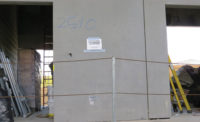Contractors on the $2.7-billion Silver Line Metro extension in northern Virginia will protect or replace 1,569 precast concrete panels used on five stations after multiple issues were discovered on hundreds of the panels.
During quality control tests of the concrete panels, Capital Rail Constructors, a partnership of Clark Construction Group and Kiewit Infrastructure South, discovered that the cement-water ratio was out of specification during early production of the panels. The panels were manufactured by Universal Concrete Supply of Stowe, Pa.
Keith Couch, project director with Capital Rail Constructors, says a probe at the concrete plant incorrectly read the moisture content of the aggregate. “Either the probe was not working properly or it was not calibrated properly,” he says.
Couch says Universal Concrete Supply initially used a standard manual method to “burn-off” moisture for testing the aggregate moisture content. In the fall, he says, the plant switched to an automated probe.
The problem was discovered in April 2017, after more than six months of production using the automated probe. At that point, the plant had cast a total of 578 panels, including 309 panels while the probe was in place. Couch says quality control inspectors were alerted by data anomalies. “The batch tickets said the water ratio was within spec,” he says. “When you went in and compared the math, the math didn’t make sense.”
CRC tested the aggregate using a manual burn-off method and discovered that the water content was reading too low, which led the system to add too much water to the final mix.
Don Faust, president of Universal Concrete Products, did not respond to calls for comment.
CRC launched a deeper investigation into the panels. Couch says that petrographic analysis revealed a low-air-entrainment issue in some panels.
Additionally, engineers with the Metropolitan Washington Airports Authority, which is overseeing Silver Line construction, discovered issues with rebar placement during a plant inspection, says Charles Stark, vice president of the Dulles Corridor Metrorail Project. “One of our engineers was in the subcontractor’s plant and noticed that as they were casting the panels, the steel reinforcement could end up too close to the surface,” he says.
CRC then conducted magnetic resonance imaging on all 1,569 panels and found 65 panels with less than ¾ in. of concrete covering the rebar. Of those, five panels were interior panels and not exposed to the elements. Engineers advised that the remaining 60 panels should be replaced. Forty-two had already been installed and crews expect to replace all of those by June, Couch says.
Since the high water content and low air entrainment could lead to future durability issues, CRC and MWAA agreed that a silane coating with corrosion inhibitor should be applied to seal all of the installed panels. The Silver Line is routed in the middle of the 10-lane Dulles Toll Road, so the exterior panels are exposed to possible salt spray during the winter, Stark says.
Couch says that consultants recommended reapplying sealant every 15 years, and the silane manufacturer was willing to go to a 20-year warranty. Out of caution, Couch says, CRC chose to reapply sealant every 10 years of the panels’ 100-year life expectancy. CRC will set up a fund to pay for future applications. Couch says CRC has not reached a financial settlement with Universal Concrete Products about the issues and future remediation. “First, we had to get the job right, then we will settle with Universal,” he adds.
Couch says the partnership’s quality control plan did its job. “We found an issue, we elevated the issue, we did an immediate investigation and we put corrective action in place.”



Post a comment to this article
Report Abusive Comment